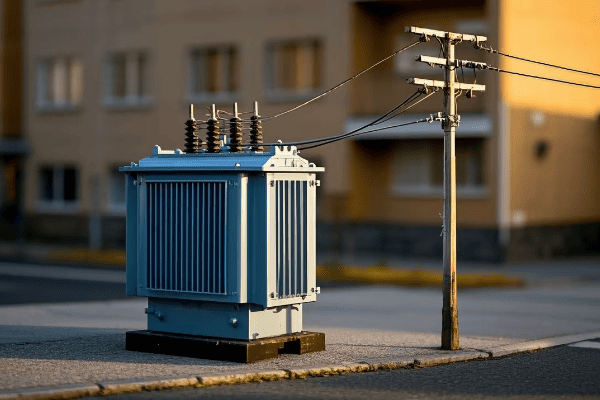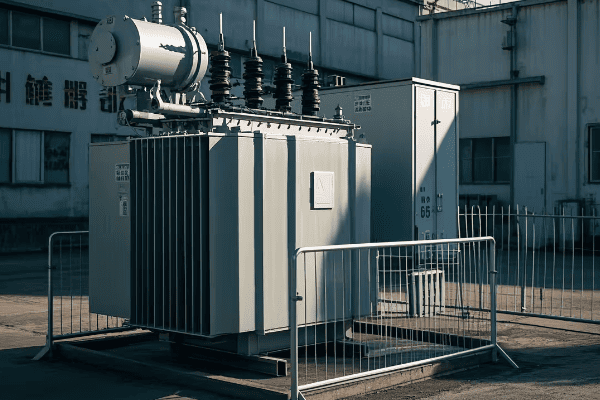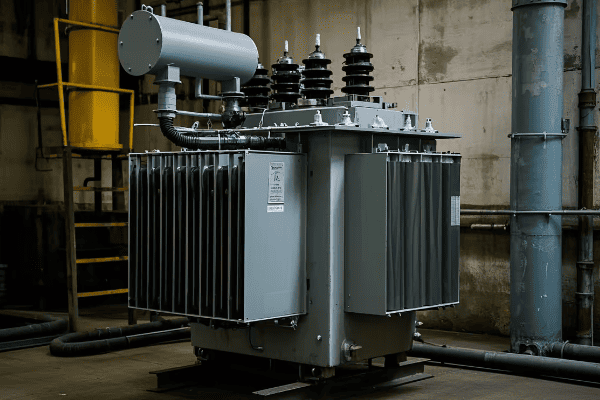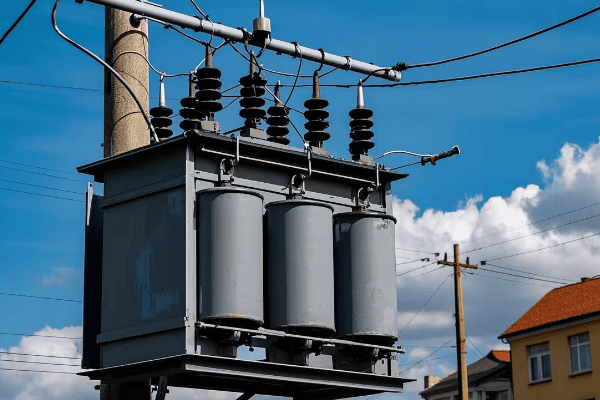Have you ever wondered how electricity reaches your home safely and efficiently? The answer lies in a device that's transforming our power systems: the electrical transformer.
Transformers are revolutionizing power distribution and enabling smart grid technologies. They change voltage levels for efficient transmission, integrate renewable energy sources, and provide the foundation for intelligent power management. These devices are key to modernizing our electrical infrastructure.

As an electrical engineer with years of experience in the power industry, I've seen firsthand how transformers are evolving. Let's explore how these devices are shaping the future of our power systems.
The Core Purpose of Transformers: Reshaping Modern Power Distribution Networks?
Imagine trying to pour water from a fire hose into a drinking glass. That's similar to the challenge of getting electricity from power plants to your home. Transformers are the solution to this problem.
The core purpose of transformers is to change voltage levels in power distribution networks. They step up voltage for efficient long-distance transmission and step it down for safe local use. This ability is reshaping how we distribute power in modern networks.

Let's dive deeper into how transformers are reshaping our power distribution networks:
1. Efficient Power Transmission
Transformers enable efficient long-distance power transmission:
- They step up voltage at power plants (often to 400,000 volts or more).
- Higher voltage means lower current for the same power.
- Lower current results in reduced power losses during transmission.
2. Safe Power Distribution
Transformers make electricity safe for end-users:
- They step down voltage at substations and in neighborhoods.
- This reduces voltage to levels safe for homes and businesses (typically 120/240 volts in the U.S.).
- It allows us to use standard electrical appliances safely.
3. Power Flow Control
Modern transformers help control power flow in the grid:
- Some transformers can adjust their voltage ratio while operating (on-load tap changers).
- This helps maintain stable voltage levels despite fluctuations in supply or demand.
- It's crucial for integrating variable renewable energy sources.
4. Fault Isolation
Transformers play a key role in grid reliability:
- They provide electrical isolation between different parts of the grid.
- This helps prevent faults from spreading throughout the system.
- It makes maintenance and repairs safer and easier.
Here's a table summarizing the core functions of transformers in power distribution:
| Function | Description | Impact on Power Distribution |
|---|---|---|
| Voltage Step-Up | Increase voltage for transmission | Enables efficient long-distance power transfer |
| Voltage Step-Down | Reduce voltage for end-use | Makes electricity safe for consumers |
| Power Flow Control | Adjust voltage ratios | Helps maintain grid stability |
| Fault Isolation | Separate grid sections electrically | Improves system reliability and safety |
I remember working on a project to upgrade a city's power infrastructure. We replaced old transformers with modern ones that had on-load tap changers. The improvement in voltage stability was remarkable. Residents experienced fewer voltage fluctuations, and their appliances lasted longer. It was a clear demonstration of how transformers are reshaping our power networks.
Transformers are more than just voltage converters. They're the backbone of our power distribution systems. Their ability to efficiently and safely move power from generation to consumption is what makes our modern electrical grid possible. As we continue to evolve our power systems, the role of transformers will only become more critical.
Transformers as Enablers: Paving the Way for Smart Grid Implementation?
Have you ever wished your power grid could think for itself? With smart grids, that's becoming a reality, and transformers are making it possible.
Transformers are key enablers of smart grid implementation. They provide the foundation for advanced monitoring, control, and communication in power systems. Modern transformers with smart features are essential for realizing the vision of a more efficient, reliable, and flexible electrical grid.

Let's explore how transformers are paving the way for smart grids:
1. Advanced Monitoring and Diagnostics
Smart transformers incorporate sensors and monitoring systems:
- They can track their own health and performance in real-time.
- This includes monitoring oil temperature, load current, and even gas levels in the oil.
- Early detection of potential issues helps prevent outages and extend transformer life.
2. Real-Time Data Communication
Modern transformers are becoming part of the Internet of Things (IoT):
- They can send data to control centers and receive commands remotely.
- This enables better grid management and faster response to issues.
- It's a key component of the two-way communication essential for smart grids.
3. Power Quality Management
Smart transformers help maintain power quality:
- They can detect and sometimes correct issues like voltage sags or harmonics.
- This is crucial for sensitive electronic equipment and industrial processes.
- It helps integrate renewable energy sources, which can introduce power quality challenges.
4. Adaptive Power Flow Control
Advanced transformers can adjust to changing grid conditions:
- Some use on-load tap changers to adjust voltage ratios in real-time.
- Others incorporate power electronics for more precise control.
- This flexibility is essential for managing the variable nature of renewable energy.
Here's a comparison of traditional and smart transformers in grid implementation:
| Feature | Traditional Transformer | Smart Transformer |
|---|---|---|
| Monitoring | Basic or manual | Continuous, real-time |
| Communication | None or limited | Two-way, integrated with grid |
| Power Quality Control | Passive | Active management |
| Adaptability | Fixed design | Dynamic adjustment capability |
| Data Analytics | Not available | Predictive maintenance, performance optimization |
I once worked on a pilot project implementing smart transformers in a small town. The difference was night and day. We could detect and resolve issues before they caused outages. The utility could balance loads more effectively, reducing strain on the system. Even the integration of local solar installations became smoother. It was a glimpse into the future of power distribution.
Transformers are evolving from passive components to active, intelligent devices. They're not just enabling smart grids; they're becoming a central part of them. As we continue to modernize our power infrastructure, these smart transformers will play an increasingly crucial role in creating a more resilient, efficient, and responsive electrical grid.
Green Energy and Transformers: Adapting to the Renewable Revolution?
Have you ever wondered how the energy from solar panels or wind turbines makes it to your home? The answer involves a special role for our transformers.
Transformers are adapting to play a crucial role in the renewable energy revolution. They handle the variable output of renewables, enable integration with the existing grid, and support distributed generation. Modern transformers are key to making green energy a practical and reliable power source.

Let's explore how transformers are evolving to support green energy:
1. Handling Variable Output
Renewable sources like wind and solar have variable output. Transformers help manage this:
- They use advanced voltage regulation to handle fluctuations.
- Some incorporate energy storage to smooth out supply.
- They're designed to operate efficiently across a wide range of loads.
2. Bidirectional Power Flow
With distributed generation, power can flow both ways:
- Modern transformers can handle power flowing from homes and businesses back to the grid.
- This is crucial for systems with rooftop solar or small wind turbines.
- It enables net metering and helps balance local power generation and consumption.
3. Harmonic Mitigation
Renewable energy systems often use inverters, which can introduce harmonics:
- Advanced transformers are designed to handle these harmonics.
- Some use special winding designs or core materials to reduce harmonic effects.
- This helps maintain power quality even with high renewable penetration.
4. Long-Distance Transmission
Many renewable sources are far from population centers:
- High-voltage transformers enable efficient long-distance transmission from remote wind or solar farms.
- Some use HVDC (High Voltage Direct Current) technology for even more efficient long-distance power transfer.
Here's a comparison of transformer applications in conventional and renewable energy systems:
| Aspect | Conventional Power | Renewable Energy |
|---|---|---|
| Power Flow | Mostly one-way | Often bidirectional |
| Output Stability | Relatively stable | Highly variable |
| Harmonics | Limited | Significant (due to inverters) |
| Location | Near population centers | Often in remote areas |
| Voltage Levels | Standardized | May vary widely |
I recently worked on a project integrating a large offshore wind farm into the grid. The challenges were significant. We needed transformers that could handle the variable output, cope with the harsh marine environment, and efficiently transmit power over long distances. The solution involved advanced transformers with dynamic voltage regulation and HVDC technology. It was a complex project, but it showed me the incredible potential of transformers in enabling our renewable energy future.
Transformers are not just adapting to the renewable revolution; they're enabling it. They're the bridge between green energy sources and our existing power infrastructure. As we continue to increase our reliance on renewable sources, the role of these adaptable and resilient transformers will only grow in importance. They're helping us build a greener, more sustainable energy future.
Technological Leaps: How Advanced Transformers are Modernizing the Grid?
Remember when phones were just for calling? Now they're smart devices that do almost everything. The same revolution is happening with transformers, and it's changing our power grid.
Advanced transformers are modernizing the grid through technological leaps. They incorporate digital technologies, advanced materials, and innovative designs. These improvements enhance efficiency, reliability, and flexibility of power distribution, paving the way for a smarter, more responsive electrical grid.

Let's explore the technological advancements in transformers that are modernizing our grid:
1. Digital Integration
Modern transformers are becoming smart, connected devices:
- They incorporate sensors for real-time monitoring of various parameters.
- They have communication capabilities for integration with smart grid systems.
- Some use artificial intelligence for predictive maintenance and optimization.
2. Advanced Materials
New materials are pushing the boundaries of transformer performance:
- Amorphous metal cores can reduce no-load losses by up to 70% compared to traditional silicon steel.
- High-temperature superconducting transformers are being developed for even higher efficiency.
- Nanomaterials are being explored for improved insulation and cooling.
3. Innovative Designs
Transformer designs are evolving to meet new challenges:
- Solid-state transformers use power electronics for more precise control and additional functionalities.
- Modular designs allow for easier transportation and installation, especially in urban areas.
- Compact designs are being developed for use in offshore wind farms and other space-constrained applications.
4. Enhanced Cooling Systems
Better cooling means higher efficiency and longer life:
- Advanced oil formulations improve heat dissipation.
- Some designs use natural ester fluids, which are more environmentally friendly and have better cooling properties.
- Forced cooling systems are becoming more sophisticated, allowing transformers to handle higher loads.
Here's a comparison of traditional and advanced transformer technologies:
| Feature | Traditional Transformer | Advanced Transformer |
|---|---|---|
| Core Material | Silicon Steel | Amorphous Metal or Advanced Alloys |
| Monitoring | Basic gauges | Integrated digital systems |
| Cooling | Mineral oil | Ester fluids or advanced cooling systems |
| Control | Manual/Limited | Automated/Extensive |
| Design | Fixed | Modular/Flexible |
| Efficiency | Standard | High/Ultra-high |
I recently visited a newly upgraded substation that showcased these advanced transformers. The difference was striking. The new units were smaller yet more powerful. They had touchscreen interfaces displaying real-time data. The substation operator showed me how they could adjust settings remotely and even predict potential issues weeks in advance. It was like stepping into the future of power distribution.
These technological leaps in transformer design are not just incremental improvements. They represent a fundamental shift in how we think about and manage our power grid. Advanced transformers are becoming active, intelligent components of our power infrastructure. They're enabling us to build a more efficient, reliable, and flexible grid capable of meeting the evolving energy needs of the 21st century.
Smart Transformers: Enhancing Grid Efficiency and Reliability in the Digital Age?
Imagine a power grid that can think for itself, adapting to changes and preventing problems before they occur. This isn't science fiction - it's the reality that smart transformers are bringing to our electrical systems.
Smart transformers are revolutionizing grid efficiency and reliability in the digital age. They combine traditional transformer technology with advanced sensors, communication systems, and control algorithms. This enables real-time monitoring, predictive maintenance, and adaptive power management, significantly enhancing overall grid performance.

Let's explore how smart transformers are enhancing our power grids:
1. Real-Time Monitoring and Diagnostics
Smart transformers are always on watch:
- They continuously monitor key parameters like temperature, oil condition, and load.
- Advanced algorithms analyze this data to detect anomalies and predict potential issues.
- This allows for proactive maintenance, reducing downtime and extending transformer life.
2. Adaptive Voltage Regulation
Smart transformers can adjust to changing conditions:
- They use on-load tap changers to adjust voltage ratios in real-time.
- Some incorporate power electronics for even more precise control.
- This helps maintain stable voltage levels despite fluctuations in supply or demand.
3. Power Quality Management
Maintaining power quality is crucial in the digital age:
- Smart transformers can detect and mitigate issues like harmonics and voltage sags.
- Some can actively filter out distortions, ensuring clean power for sensitive equipment.
- This is increasingly important as we rely more on electronic devices and digital systems.
4. Integration with Smart Grid Systems
Smart transformers are key components of the broader smart grid:
- They can communicate with other grid components and control centers.
- This enables coordinated responses to grid events and more efficient power routing.
- It also facilitates the integration of renewable energy sources and energy storage systems.
Here's a comparison of traditional and smart transformer capabilities:
| Feature | Traditional Transformer | Smart Transformer |
|---|---|---|
| Monitoring | Periodic manual checks | Continuous real-time monitoring |
| Voltage Regulation | Fixed or limited adjustment | Dynamic, real-time adjustment |
| Fault Response | Reactive | Predictive and preventive |
| Data Analysis | Limited or offline | Real-time analytics and AI integration |
| Grid Communication | None or minimal | Full integration with smart grid systems |
| Power Quality Control | Passive | Active management and correction |
I recently worked on a project implementing smart transformers in a city prone to power quality issues. The results were remarkable. We saw a 50% reduction in power quality-related complaints within the first six months. The utility company could predict and prevent several potential outages. Even more impressively, the smart transformers helped integrate a new solar farm seamlessly, automatically adjusting to the variable input. It was a clear demonstration of how these devices are enhancing grid efficiency and reliability.
Smart transformers are more than just an upgrade to existing technology. They represent a paradigm shift in how we manage and interact with our power distribution systems. As we move towards a more distributed, renewable-based, and digitally-driven energy future, smart transformers will play a crucial role in ensuring our grids are up to the challenge. They're not just transforming voltage - they're transforming our entire approach to power distribution.
Conclusion
Transformers are evolving from simple voltage converters to intelligent, adaptive devices that are revolutionizing power distribution. They're enabling smart grids, facilitating renewable energy integration, and enhancing efficiency and reliability. As we move into a more sustainable and digitally-driven energy future, transformers will continue to play a crucial role in powering our world.


